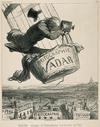A4A-Photography Flashcards

Louis-Jacques-Mandé Dagurerre (French)
Still Life in Studio, 1837
Daguerreotype, 6 ¼’’ x 8 ¼”
One of the first plates Daguerre produced after perfecting his new photographic process was this still life, in which he was able to capture amazing detail and finely graduated tones of light and shadow. (A4A.27-48)

Josiah Johnson Hawes and Albert Sands Southworth (American)
Early Operation under Ether, Massacusetts General Hospital, ca. 1847
Daguerreotype, 6 ½’’ x 8 ½”
In this early daguerreotype, which predates Eakin’s The Gross Clilnic by almost 30 years, Hawes and Southworth demonstrated the documentary power of the new medium of photography. (A4A.27-49)

Nadar (French)
Eugéne Delacroix, ca. 1855
Modern print from the original negative, 8 ½’’ x 6 ⅔”
Nadar was one of the earliest portrait photographers. His prints of the leading artists of the day, such as this one of Delacroix, reveal the sitters’ personalities as well as record their features. (A4A.27-50)

Honoré Daumier (French)
Nadar Raising Photography to the Height of Art, 1862
Lithograph, 10 ¾’’ x 8 ¾”
Daumier’s lithograph of Nadar in a balloon “elevating the art of photography” commemorates a court decision acknowledging photographs as artworks protected by copyright. (A4A.27-51)

Eadweard Muybridge (English)
Horse Galloping, 1878
Calotype print
Muybridge specialized in photographic studies of the sucessive stages in human and animal motion–details too quick for the human eye to capture. Modern cinema owes a great deal to his work. (A4A.27-54)

Timothy O’Sullivan (Irish American)
A Harvest of Death, Gettysburg, Pennsylvania, 1863
Negative by Timothy O’Sullivan, Albumen print by Alexander Gardner, 6 ¾’’ x 8 ¾”
Wet-plate technology enabled photographers to record historical events on the spot—and to comment on the high price of war, as in this photograph of dead Union soldiers at Gettysburg. (A4A.27-53)

Julia Margaret Cameron (British)
Ophelia, Study No. 2, 1867
Albumen print, 1’ 1’’ x 10 ⅔”
Cameron was a prominent 19th-century photographer who often depicted her female subjects as characters in literary or biblical narratives. The slightly blurred focus is a distinctive feature of her work. (A4A.27-52)


